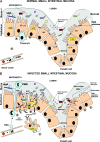Bacteria in the intestine, helpful residents or enemies from within?
- PMID: 18474643
- PMCID: PMC2493210
- DOI: 10.1128/IAI.00187-08
Bacteria in the intestine, helpful residents or enemies from within?
Figures

References
-
- Asakura, H., and M. Yoshioka. 1994. Cholera toxin and diarrhoea. J. Gastroenterol. Hepatol. 9186-193. - PubMed
-
- Bamba, T., H. Matsuda, M. Endo, and Y. Fujiyama. 1995. The pathogenic role of Bacteroides vulgatus in patients with ulcerative colitis. J. Gastroenterol. 30(Suppl. 8)45-47. - PubMed
-
- Beamer, L. J., S. F. Carroll, and D. Eisenberg. 1997. Crystal structure of human BPI and two bound phospholipids at 2.4 angstrom resolution. Science 2761861-1864. - PubMed
-
- Begue, B., C. Dumant, J. C. Bambou, J. F. Beaulieu, M. Chamaillard, J. P. Hugot, O. Goulet, J. Schmitz, D. J. Philpott, N. Cerf-Bensussan, and F. M. Ruemmele. 2006. Microbial induction of CARD15 expression in intestinal epithelial cells via Toll-like receptor 5 triggers an antibacterial response loop. J. Cell Physiol. 209241-252. - PubMed
Publication types
MeSH terms
Grants and funding
LinkOut - more resources
Full Text Sources

